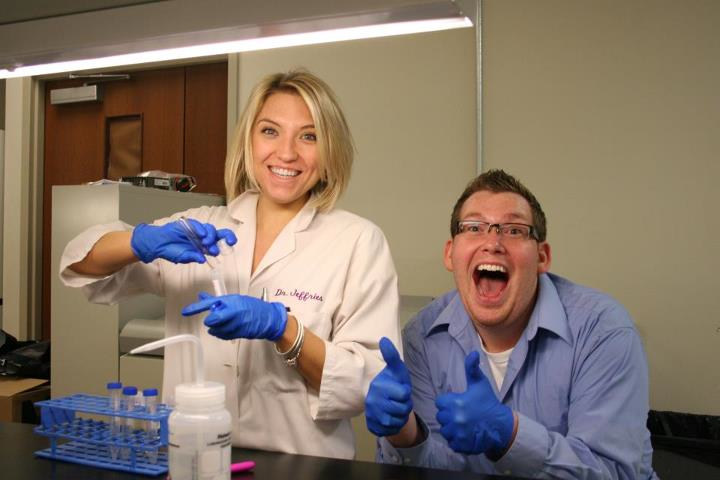Team:UTK-Knoxville/Safety
From 2012.igem.org
(Difference between revisions)
| (8 intermediate revisions not shown) | |||
| Line 1: | Line 1: | ||
{{:Utk knoxville basic template}} | {{:Utk knoxville basic template}} | ||
| - | <div | + | <div id="box" style="width: 450px; float:left; margin-left: 75px; padding: 25px; border:5px solid#f77f00; background-color: #F0EDE4;"> |
| - | <div style="font-size: | + | <div style="font-size:25pt;"> |
| - | + | <b style="color:#4C4D4F;">iGEM Safety </b> | |
| - | <b style="color:#4C4D4F;">Safety | + | |
</div> | </div> | ||
| + | [[File:Katie and Donovan in the lab.jpg|400px|center]] | ||
| + | |||
| + | |||
| + | |||
<p>A key component of effective, responsible scientific research is a concern for how it is performed. Researchers have an obligation to know the risks involved with their work and contain those risks, for their own sakes and for that of the public. </p> | <p>A key component of effective, responsible scientific research is a concern for how it is performed. Researchers have an obligation to know the risks involved with their work and contain those risks, for their own sakes and for that of the public. </p> | ||
<p>The University of Tennessee’s Office of Research has a very specific biosafety training program that anyone working in their laboratories has to complete. The specifics can be found [http://biosafety.utk.edu/index.shtml here], but basically it covers things such as safe handling, storage and disposal of chemical and biological reagents and associated materials, proper lab attire, sterile techniques, and promotion of a safe working environment in general. Regular inspections are carried out to ensure continual compliance with [http://biosafety.utk.edu/manuals/ federal biosafety standards], and training is repeated every year. </p> | <p>The University of Tennessee’s Office of Research has a very specific biosafety training program that anyone working in their laboratories has to complete. The specifics can be found [http://biosafety.utk.edu/index.shtml here], but basically it covers things such as safe handling, storage and disposal of chemical and biological reagents and associated materials, proper lab attire, sterile techniques, and promotion of a safe working environment in general. Regular inspections are carried out to ensure continual compliance with [http://biosafety.utk.edu/manuals/ federal biosafety standards], and training is repeated every year. </p> | ||
<p>All iGEM research was carried out in a Biosafety Level 2 (BSL2)-certified laboratory, which covers organisms potentially infectious but only moderately hazardous to humans. The yeast and bacterial strains used in our research are not infectious to humans, but some of our parts were isolated from viral DNA, the sources for which are fully documented in the interest of full disclosure for future experimentalists. Under the containment protocols of BSL2 certification, minimal risk exists for all researchers and hazards to the public are effectively eliminated.</p> | <p>All iGEM research was carried out in a Biosafety Level 2 (BSL2)-certified laboratory, which covers organisms potentially infectious but only moderately hazardous to humans. The yeast and bacterial strains used in our research are not infectious to humans, but some of our parts were isolated from viral DNA, the sources for which are fully documented in the interest of full disclosure for future experimentalists. Under the containment protocols of BSL2 certification, minimal risk exists for all researchers and hazards to the public are effectively eliminated.</p> | ||
<p>Safety is a priority for us as researchers, and we have conscientiously implemented the necessary protocols to look out for the wellbeing of the environment, the public, and everyone working in our laboratory.</p> | <p>Safety is a priority for us as researchers, and we have conscientiously implemented the necessary protocols to look out for the wellbeing of the environment, the public, and everyone working in our laboratory.</p> | ||
| + | </div> | ||
| + | <div id="box" style="width: 225px; float:right; margin-right: 75px; padding: 25px; border:5px solid#f77f00; background-color: #F0EDE4;"> | ||
| + | <div style="align=center; font-size:18pt; color=#4c4d4f;"> | ||
| + | Click [https://2012.igem.org/UTK-Knoxville/SafetyQuestions here] to see the answers to our safety questions. | ||
| + | </div> | ||
| + | </div> | ||
| + | <div id="box" style="width: 225px; float:right; margin-right: 75px; margin-top: 15px; padding: 25px; border:5px solid#f77f00; background-color: #F0EDE4;"> | ||
| + | <div style="align=center; font-size:18pt; color=#4c4d4f;"> | ||
| + | Want to learn more about our safety precautions for our high school team member? Click [https://2012.igem.org/UTK-Knoxville/BrandonSafety here] | ||
</div> | </div> | ||
</div> | </div> | ||
Latest revision as of 01:12, 24 September 2012
 "
"

